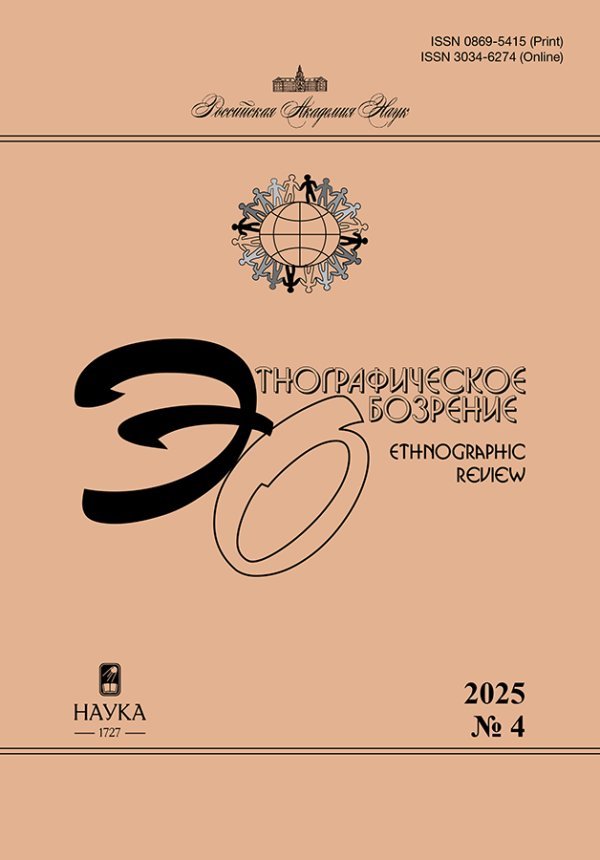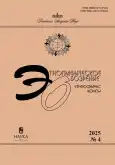Ainu Traditional Dance as an Exhibit of Museum Culture and as an Element of Ethnic Tourism
- Authors: Osipova M.V.1
-
Affiliations:
- Peter the Great Museum of Anthropology and Ethnography (Kunstkamera), Russian Academy of Sciences
- Issue: No 4 (2025)
- Pages: 9-21
- Section: Special Theme of the Issue: Ethnography of Performing Arts (guest editor S.I. Ryzhakova)
- URL: https://stomuniver.ru/0869-5415/article/view/697012
- DOI: https://doi.org/10.31857/S0869541525040025
- ID: 697012
Cite item
Abstract
Ainu traditional dance is an integral part of folk culture, which is connected with rituals, songs and music. Nowadays, however, real rituals are not carried out and the dance that used to accompany them has turned into a cultural phenomenon which has absorbed both traditional content and new elements. Ainu dance has become a spectacular art; it is being revived and supported in museum complexes in Hokkaido, and the process of its museumification is underway. The dance is turning into a kind of museum exhibit, which requires “ethnographic accuracy” in its performance. But museums are institutions intended for the public, and they are part of the modern tourism industry. Therefore, the problem of the purposes and scope of reproducing authentic material arises. On the other hand, the dance should be spectacular and understandable to different groups of spectators. The article attempts to analyze the conditions that were instrumental in transforming the Ainu ritual dance into an exhibit of museum culture and the ways of its transition into an element of ethnic tourism.
Keywords
About the authors
M. V. Osipova
Peter the Great Museum of Anthropology and Ethnography (Kunstkamera), Russian Academy of Sciences
Author for correspondence.
Email: ainu07@mail.ru
ORCID iD: 0000-0001-9486-1861
к. и. н., доцент, старший научный сотрудник отдела этнографии Сибири 3 University Emb., St. Petersburg, 199034, Russia
References
- Glushkova, P.V. 2015. Klassifikatsiia muzeev pod otkrytym nebom v aspekte aktualizatsii nematerial’nogo kul’turnogo naslediia [Classification of Open-Air Museums in Terms of Actualization of Intangible Cultural Heritage]. Vestnik Kemerovskogo gosudarstvennogo universiteta 1 (61/1): 59–63.
- Hiwasaki, L. 2000. Ethnic Tourism in Hokkaido and the Shaping of Ainu Identity. Pacific Affairs 73 (3): 393–412.
- Hunter, J. 2015. Vitalizing Traditions: Ainu Music and Dance and the Discourse of Indigeneity. PhD diss., University of Hawaii at Manoa, 2015.
- Kachura, A.E. 2018. Stsenicheskaia interpretatsiia narodnogo tantsa i ego sozdaniia [Stage Interpretation of Folk Dance and Its Creation]. Filosofsko-kul’turologicheskie issledovaniia 3. http://fki.gaki.info/2018/05/02/сценическая-интерпретация-народного
- Kagan, M.S. 1972. Morfologiia iskusstva. Istoriko-teoreticheskoe issledovanie vnutrennego stroeniia mira iskusstv [Morphology of Art: Historical and Theoretical Study of the Internal Structure of the World of Art]. Pt. I, II, III. Moscow: Iskusstvo.
- Katsuya, H. 2009. The Politics of Colonial Translation: On the Narrative of the Ainu as a “Vanishing Ethnicity”. The Asia-Pacific Journal 7/4 (3). https://apjjf.org/-Katsuya-Hirano/3013/article.html
- Kayano, S. 1994. Our Land was a Forest: An Ainu Memoir. Boulder: Westview Press, 1994.
- Nakamura, N. 2007. The Representation of Ainu Culture in the Japanese Museum System. The Canadian Journal of Native Studies 27 (2): 331–365.
- Osipova, M.V. 2019. Ainskii tanets: ot igrovogo k zrelishchnomu (Ocherki o tantseval’noi kul’ture ainov Sakhalina, Kuril’skikh ostrovov i o. Khokkaido) [Ainu Dance: From Playful to Spectacular (Essays on the Dance Culture of the Ainu of Sakhalin, the Kuril Islands and Hokkaido)]. Khabarovsk: ID “Grand Ekspress”.
- Peng, F.C.C., R. Ricketts, and N. Imamura. 1974. The Socioeconomic Status of the Ainu: Past and Present. American Ethnologist 1 (4): 731–750.
- Pilsudskii, B.O. 2007. Na medvezh’em prazdnike aynov [At the Ainu Bear Festival]. In Ayny Yuzhnogo Sakhalina (1902–1905 gg.) [Ainu of Southern Sakhalin (1902–1905)], by B.O. Pilsudskii, 107–206. Yuzhno-Sakhalinsk: Sakhalinskoe knizhnoe izdatel’stvo.
- Porter, C. 2008. After the Ainu Shinpo: The United Nations and the Indigenous People of Japan. New Voices 2: 201–219. http://dx.doi.org/10.21159/nv.02.10
- Pratt, M.L. 2007. Imperial Eyes: Travel Writing and Transculturation. London: Routledge.
- Sasaki, S. 2022. Kokuritsu Ainu minzoku hakubutsukan no setsuritsu to hatasubeki yakuwari [Establishment of the National Ainu Museum and Its Role]. National Ainu Museum Journal 1: 9–39.
- Siddle, R. 1996. Race, Resistance, and the Ainu of Japan Sheffield Centre for Japanese Studies. London: Routledge.
- Sjöberg, K. 1993. The Return of the Ainu: Cultural Mobilization and the Practice of Ethnicity in Japan. Amsterdam: Нarwood Academic Publishers.
- Tsunemoto, T. 1999. The Ainu Shinpo: A New Beginning. In Ainu: Spirit of a Northern People, edited by W.W. Fitzhugh and C.O. Dubreuil, 366–369. New York: Arctic Studies Center; National Museum of Natural History; Smithsonian Institution; University of Washington Press.
- Yachita, M. 2022. “Ainu koshiki buyō” no bunkazai shitei no ikisatsu ni kansuru kōsatsu – chiri mashiho to honda yasuji no genkō kara [A Study on the Designation Process of “Traditional Ainu Dance” as Japan’s Cultural Property: Examination of the Manuscripts of Chiri Mashiho and Honda Yasuji]. National Ainu Museum Journal 1: 114–131.
Supplementary files











